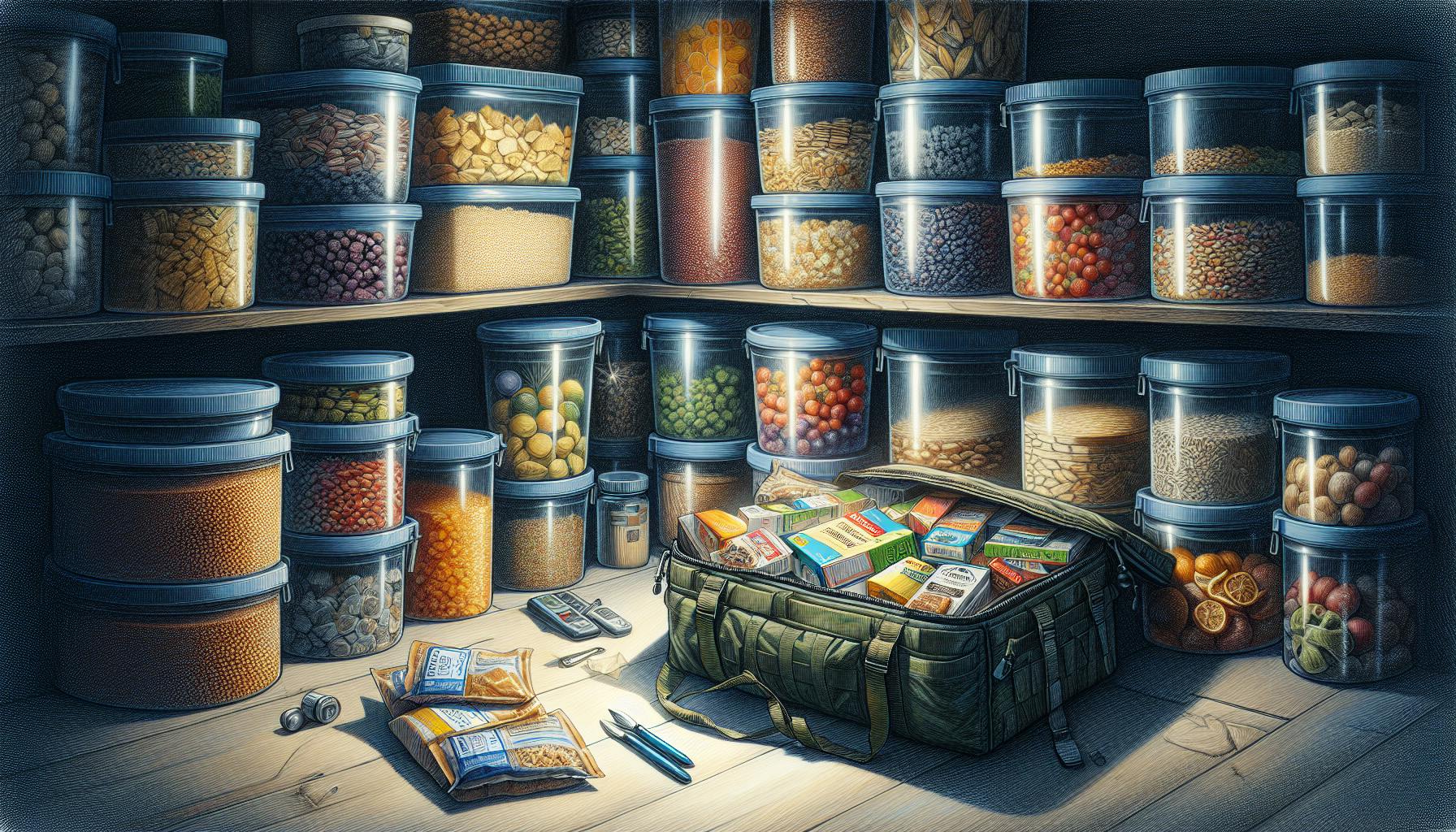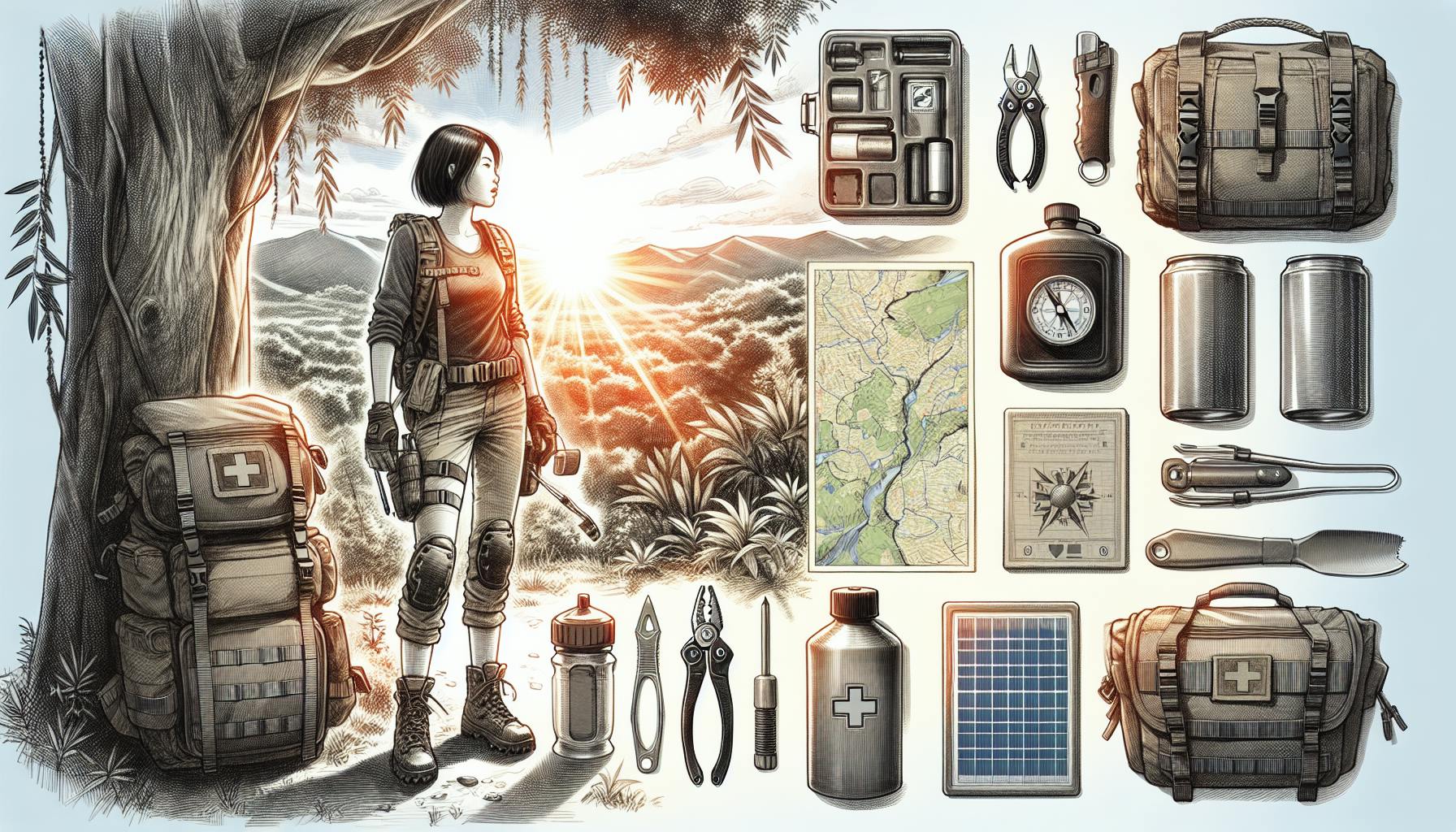When venturing into the wilderness, most would agree it's crucial to prepare for potential injuries and illnesses by packing a well-stocked survival first aid kit.
The right supplies can make all the difference in an emergency, allowing you to effectively treat issues from cuts and burns to breaks and sprains until professional help is available.
In this post, we'll explore the essential items your survival medical kit should contain - from basic wound care components to medications and tools - ensuring you're ready for the most common outdoor medical situations.
Planning Your Survival First Aid Kit
Assembling a well-stocked survival first aid kit is crucial for emergency preparedness when venturing into the wilderness. By considering likely injuries, storage needs, and environmental factors, you can customize a kit to address your specific situation.
Assessing Probable Injuries and Illnesses
Focus on supplies to treat:
- Sprains and fractures from slips or falls
- Cuts and scrapes from sharp objects or terrain
- Allergic reactions from plants, insects, medications
- Fever, diarrhea from water contamination or wildlife diseases
Also prepare for heat stroke, hypothermia, dehydration depending on your location.
Choosing Durable, Portable Materials
Prioritize lightweight, packable items in durable containers:
- Waterproof bag or hard-shell case
- Non-perishable medications and wound dressings
- Multi-use tools like a survival knife or flashlight
Condense and organize using modular pouches to save space.
Understanding Expiration Dates of Medications
Check expiration dates and properly dispose of any expired antibiotics, pain relievers, antihistamines. Maintain an inventory with purchase/expiration dates.
Considering Your Activity Level and Duration
Gauge quantities needed for longer trips farther from hospitals. Activities like mountain climbing require more robust supplies than short day hikes. Prepare for multiple injuries if traveling in a group.
Customizing for Environmental Factors
Mountainous areas call for altitude sickness meds and cold weather items. Desert locales need electrolyte replacements for dehydration. Tropical climates require insect bite treatments and sunburn relief. Personalize for probable regional risks.
Careful planning allows you to handle injuries effectively when professional medical care is limited or delayed. Evaluate likely scenarios and medical needs to create a tailored survival first aid kit for your situation.
What do you need in a survival kit?
A well-stocked survival first aid kit is essential for handling injuries and illnesses when access to professional medical care is limited. Here are some of the most important items to include:
First Aid Supplies
- Sterile gauze pads and rolls - for covering wounds
- Adhesive bandages - provide protection and support
- Antiseptic wipes - clean wounds and prevent infection
- Antibiotic ointment - prevents infection in minor cuts and scrapes
- Medical tape - secure dressings and bandages
- Elastic wrap bandages - support injured joints and muscles
Medications
- Ibuprofen or acetaminophen - relieve pain and reduce fever
- Antihistamine - treat allergic reactions
- Antidiarrheal medication
- Electrolyte tablets - replace nutrients lost from vomiting or diarrhea
Tools and Other Gear
- Scissors - cut clothing or dressings
- Tweezers - remove debris from wounds
- Safety pins - fasten bandages
- Thermometer
- Gloves - protect hands when treating others
Be sure to check expiration dates and replace anything that has expired. Consider personalizing your survival first aid kit with any necessary medications or supplies for your family's specific needs. Having the right gear on hand can make a critical difference during an emergency situation.
What should be in a combat first aid kit?
A well-stocked combat first aid kit is critical for military personnel and preppers alike. Here are some of the most essential items to include:
Stop Severe Bleeding
- Tourniquets - These restrict blood flow and are used for severe bleeding from limbs. Examples include the CAT or SOFTT tourniquets.
- Hemostatic agents - Help stop bleeding quickly. Popular options are Celox and QuikClot.
- Pressure dressings - Apply to wounds to control bleeding. Include several sterile gauze pads and elastic bandages.
Clear Airway Obstructions
- Nasopharyngeal airways - Help keep airways open if someone is unconscious. Come in various sizes.
- Suction devices - Clear mucus to open airways. A manual one like the Redi-Vac is portable.
Treat Burns
- Burn dressings - Sterile, non-stick pads to protect burns from infection. Silvadene cream also helps prevent infection.
- Burn sheets - Sterile sheets that conform to body to cover large burns.
Having the right survival first aid kit items on hand could save a life during critical moments. Military personnel face combat risks daily, while preppers recognize the value of preparedness. Equipping yourself with these essentials ensures you can handle common injuries when help is not readily available.
What is in a survival medical kit?
A well-stocked survival medical kit is essential for handling injuries and illnesses when access to professional medical care is limited. Here are some of the most important items to include:
Basic Medical Supplies
- Adhesive tape
- Elastic wrap bandages
- Assorted sizes of bandage strips and "butterfly" bandages
- Super glue
- Rubber tourniquet or catheter
- Sterile gauze pads and roller bandages
- Eye shield or pad
- Triangular bandage that can be used as a sling
These basic medical supplies allow you to dress wounds, immobilize injuries, and deal with common issues like blisters. Having materials on hand to create splints is also important.
Medications and Ointments
- Anti-inflammatory pills (ibuprofen)
- Antihistamine pills and creams
- Antiseptic ointments and solutions
- Anti-diarrheal medication
- Oral rehydration salts
- Electrolyte tablets/powders
- Antacid tablets
- Anti-nausea medication
- Pain relievers
- Burn cream/gel/spray
Stocking a variety of over-the-counter medications can relieve symptoms and promote healing for illnesses and injuries when professional care is delayed. Be sure to check expiration dates regularly.
Tools and Other Gear
- Flashlight
- Tweezers
- Safety pins
- Thermometer
- Medical gloves
- Cold packs
- Emergency blanket
- Medical tape
- Scissors
- Notebook and pen
Having the right tools and gear makes it easier to assess and treat medical issues. Safety gear like gloves protects both the patient and caregiver.
Tailor your survival medical kit based on likely risks given your location and activities. The goal is having what you need to stabilize patients and manage conditions until you can get professional medical care. Check and resupply your kit regularly.
What 10 items would be in a first aid kit?
Here are some essential items to include in a survival first aid kit:
-
Examination gloves - Protect your hands when treating injuries. Nitrile gloves are best.
-
Adhesive bandages - Assorted sizes of bandaids for minor cuts and scrapes.
-
Medical tape - Useful for securing dressings or bandages. Waterproof tape works best.
-
Antiseptic wipes - Clean dirt and debris from wounds to prevent infection. Look for alcohol-free wipes.
-
Antibiotic ointment - Apply to superficial wounds to prevent bacteria growth and infection.
-
Burn gel - Soothe and cool minor burns. Aloe vera gel also works well.
-
Anti-diarrheal medication - Treat diarrhea from unclean water or food.
-
Antihistamine tablets - Alleviate allergy symptoms and reactions.
-
Pain relief tablets - Relieve aches, pains, headaches. Acetaminophen, ibuprofen, or naproxen.
-
Space blanket - Retain body heat to prevent hypothermia. Useful temporary shelter.
The above covers common issues like wounds, burns, allergies. Adapt your survival medical kit based on your skill level, environment, and potential medical needs. Periodically inspect and replace expired items.
sbb-itb-b932644
Survival First Aid Kit List: The Fundamentals
A comprehensive survival first aid kit serves as the foundation for emergency medical preparedness. Having the right supplies on hand can help manage injuries and illnesses when professional medical care is not readily available. This list covers first aid basics for wilderness, disaster, and everyday preparedness.
Bandages and Gauze Pads
Bandages and gauze pads in multiple sizes are essential for treating wounds and controlling bleeding. Small bandages can cover minor cuts, while larger pads and rolled gauze are useful for securing pressure on deeper lacerations and protecting sprains. Sterile gauze helps prevent infection.
Antibiotic Ointment Packets
Single-use antibiotic ointment packets are a convenient addition to survival kits. Applying antibiotic ointment to scrapes, burns, blisters, and even insect bites helps prevent infection. The individually wrapped packets maintain sterility in the wild.
Alcohol Prep Pads
Alcohol prep pads serve an important role in first aid by sterilizing skin and tools during wound care. They enable safe minor medical procedures in unsanitary post-disaster environments. Alcohol also sanitizes hands when soap and water are scarce.
Medical Tape
Medical tape is critical for securing dressings, gauzes, and other items in emergency injury treatment. Waterproof varieties avoid saturation in wet conditions. Tape also enables creative solutions like taping gloves around injured fingers.
Gloves
Wearing latex or other gloves reduces disease transmission when treating bloody wounds. Gloves preserve sterility during procedures, preventing introduction of bacteria and pathogens into open injuries. They also protect aid givers from exposure. Nitrile and vinyl gloves work for those with latex allergies.
Best Survival First Aid Kit: Advanced Components For Wilderness Survival Prep
Additional critical treatment gear for intense activities in extreme backcountry environments, contributing to the best survival first aid kit configurations.
Trauma Pads
Thicker pads and wraps such as Israeli bandages or compression wraps can help manage bleeding from major lacerations, abrasions, or punctures. These provide more absorption and pressure than basic gauze pads. Useful for wrapping limbs or applying direct pressure to wounds.
Tourniquet
A tourniquet, like the CAT or SOFTT-W models, is essential for stopping severe bleeding from arms or legs when pressure or bandages fail. Can be lifesaving if properly applied in emergency trauma cases.
Emergency Blanket
A lightweight, reflective emergency blanket made of heat-reflective thin plastic sheeting can help conserve body heat and prevent hypothermia. Useful for treating shock or weather exposure in the wilderness when shelter is limited.
Splint Materials
Firm padding boards, SAM splints, or improvised splints made of sticks/poles can immobilize fractures and prevent further injury until professional medical care is reached. Stabilizing broken bones is vital.
Skin Closure Strips
Having butterfly bandages or steri-strip skin closure strips on hand enables pulling together and holding deeper cuts closed until proper stitches can be applied by a medical professional. Helps prevent infection risk.
Outdoor Survival First Aid Kit: Medications to Include For Severe Pain and Infection
Powerful OTC and prescription meds to manage inflammation, aches, fever, and sickness in an outdoor survival first aid kit.
Anti-Inflammatory Pills
Over-the-counter anti-inflammatory medications like ibuprofen (Advil, Motrin) or naproxen (Aleve) can help reduce swelling, pain, fever and inflammation. These should be included in any wilderness first aid kit. Take as directed for headaches, sprains, breaks, etc.
Antidiarrheal Medication
Severe diarrhea from contaminated water or poor sanitation can quickly lead to dangerous dehydration outdoors. Pack antidiarrheal meds like Pepto-Bismol tablets to help stop watery bowel movements and calm stomach issues.
Oral Rehydration Salts
Dehydration is a major risk in a survival scenario. Carry electrolyte replacement powders or tablets (e.g. DripDrop, Pedialyte). Mixing them with clean water and drinking can prevent and treat dehydration from diarrhea, vomiting, fever or sweating.
Antibiotic Ointments
Applying topical antibiotic creams/ointments like Neosporin to cuts, burns or scrapes can prevent bacterial infection and promote healing when medical care is limited.
Prescribed Oral Antibiotics
For severe wound infection cases, potent oral antibiotics like Amoxicillin may be prescribed by a doctor. When possible, get an emergency supply prescribed to carry in wilderness/disaster first aid kids. Use judiciously for serious infections.
Military First Aid Kit: Additional Tools and Misc. Survival First Aid Gear
A military first aid kit contains supplementary items that enhance medical response and survival capability in an emergency situation. These additional tools serve specific purposes beyond basic first aid administration.
Medical Scissors and Tweezers
Medical scissors and tweezers have utility for:
- Cutting away clothing from wounds
- Removing debris, shrapnel, etc from wounds
- Extracting splinters, ticks, stingers, etc
Quality medical scissors and tweezers are essential items in a survival first aid kit.
Instant Cold Packs
Instant cold packs activate through a chemical reaction when squeezed or struck, providing emergency cold treatment for:
- Swelling
- Bruising
- Sprains
The ability to make ice packs on demand makes these a versatile tool to include in your outdoor survival first aid kit.
Sam Splint
A Sam Splint is a lightly padded, customizable aluminium splint used to immobilize suspected fractures in survival situations. Key features:
- Moldable to limb
- Retains rigidity for support
- Reusable
- Ultra lightweight
The Sam Splint provides emergency fracture care in the field when medical transport is delayed or unavailable. An important addition for the best survival first aid kit.
Space Emergency Blanket
Space emergency blankets (also known as space blankets or mylar blankets) reflect and retain body heat to prevent hypothermia. Characteristics:
- Ultra lightweight
- Ultra packable
- Waterproof and windproof
These blankets are a must-have item for your survival first aid kit list.
Water Purification Tablets
Water purification tablets eliminate microbial contaminants from questionable water sources to prevent illness. This is achieved by:
- Killing bacteria
- Inactivating viruses
- Removing parasites
Access to potable water is critical. Military first aid kits should contain water purification tablets.
Final Tips for Your Survival First Aid Prep
As you prepare your survival first aid kit, here are some final tips to ensure it meets your needs when the unexpected happens:
Layer Supplies Based on Severity
Tier your supplies so that minor first aid items are most accessible, while gear for severe trauma is protected deeper in the bag. This allows you to grab what you need quickly.
Store in Waterproof Bag
Store your entire medical kit in a durable, waterproof bag or case. This keeps everything clean, dry and organized.
Refresh Expiring Components Yearly
Check expiration dates on medications, ointments, sterile dressings etc. once a year. Replace any outdated components to ensure effectiveness.
Learn Basic Medical Skills
Having the right gear is crucial, but medical training is equally important. Consider getting wilderness first aid certification to complement your supplies.
Customize for Your Needs
Tailor your medical supplies to your health, risk factors and environment. For example, add an EpiPen if you have allergies, or ace bandages if you're prone to sprains. Customize as needed.


